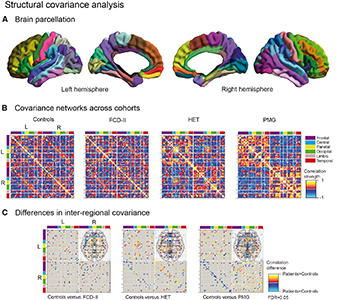Abstract
Neuroimaging studies of malformations of cortical development have mainly focused on the characterization of the primary lesional substrate, while whole-brain investigations remain scarce. Our purpose was to assess large-scale brain organization in prevalent cortical malformations. Based on experimental evidence suggesting that distributed effects of focal insults are modulated by stages of brain development, we postulated differential patterns of network anomalies across subtypes of malformations. We studied a cohort of patients with focal cortical dysplasia type II (n = 63), subcortical nodular heterotopia (n = 44), and polymicrogyria (n = 34), and compared them to 82 age- and sex-matched controls. Graph theoretical analysis of structural covariance networks indicated a consistent rearrangement towards a regularized architecture characterized by increased path length and clustering, as well as disrupted rich-club topology, overall suggestive of inefficient global and excessive local connectivity. Notably, we observed a gradual shift in network reconfigurations across subgroups, with only subtle changes in focal cortical dysplasia type II, moderate effects in heterotopia and maximal effects in polymicrogyria. Analysis of resting state functional connectivity also revealed gradual network changes, with most marked rearrangement in polymicrogyria; contrary to findings in the structural domain, however, functional architecture was characterized by decreases in both local and global parameters. Diverging results in the structural and functional domain were supported by formal structure-function coupling analysis. Our findings support the concept that time of insult during corticogenesis impacts the severity of topological network reconfiguration. Specifically, late-stage malformations, typified by polymicrogyria, may selectively disrupt the formation of large-scale cortico-cortical networks and thus lead to a more profound impact on whole-brain organization than early stage disturbances of predominantly radial migration patterns observed in cortical dysplasia type II, which likely affect a relatively confined cortical territory.

